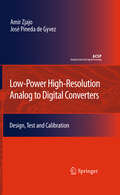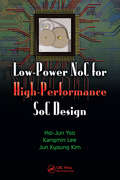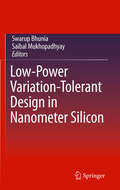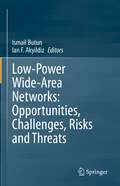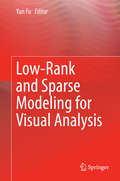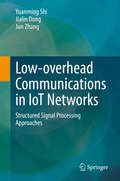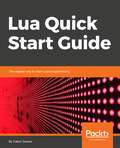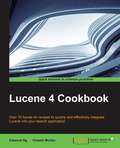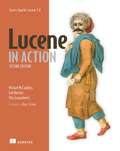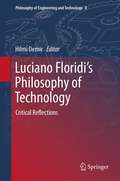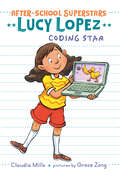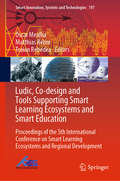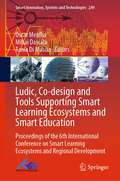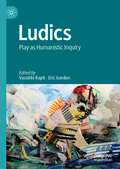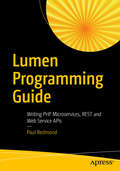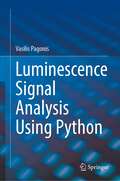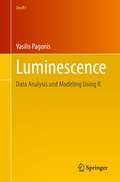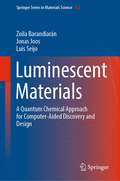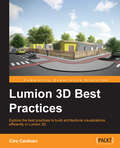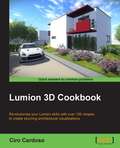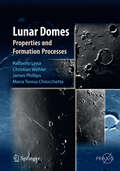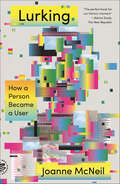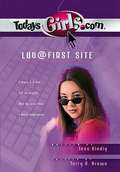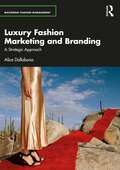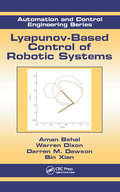- Table View
- List View
Low-Power High-Resolution Analog to Digital Converters
by Amir Zjajo José Pineda de GyvezWith the fast advancement of CMOS fabrication technology, more and more signal-processing functions are implemented in the digital domain for a lower cost, lower power consumption, higher yield, and higher re-configurability. This has recently generated a great demand for low-power, low-voltage A/D converters that can be realized in a mainstream deep-submicron CMOS technology. However, the discrepancies between lithography wavelengths and circuit feature sizes are increasing. Lower power supply voltages significantly reduce noise margins and increase variations in process, device and design parameters. Consequently, it is steadily more difficult to control the fabrication process precisely enough to maintain uniformity. The inherent randomness of materials used in fabrication at nanoscopic scales means that performance will be increasingly variable, not only from die-to-die but also within each individual die. Parametric variability will be compounded by degradation in nanoscale integrated circuits resulting in instability of parameters over time, eventually leading to the development of faults. Process variation cannot be solved by improving manufacturing tolerances; variability must be reduced by new device technology or managed by design in order for scaling to continue. Similarly, within-die performance variation also imposes new challenges for test methods. In an attempt to address these issues, Low-Power High-Resolution Analog-to-Digital Converters specifically focus on: i) improving the power efficiency for the high-speed, and low spurious spectral A/D conversion performance by exploring the potential of low-voltage analog design and calibration techniques, respectively, and ii) development of circuit techniques and algorithms to enhance testing and debugging potential to detect errors dynamically, to isolate and confine faults, and to recover errors continuously. The feasibility of the described methods has been verified by measurements from the silicon prototypes fabricated in standard 180nm, 90nm and 65nm CMOS technology.
Low-Power NoC for High-Performance SoC Design (System-on-Chip Design and Technologies)
by Hoi-Jun Yoo Kangmin Lee Jun Kyong KimChip Design and Implementation from a Practical Viewpoint Focusing on chip implementation, Low-Power NoC for High-Performance SoC Design provides practical knowledge and real examples of how to use network on chip (NoC) in the design of system on chip (SoC). It discusses many architectural and theoretical studies on NoCs, including design methodology, topology exploration, quality-of-service guarantee, low-power design, and implementation trials. The Steps to Implement NoC The book covers the full spectrum of the subject, from theory to actual chip design using NoC. Employing the Unified Modeling Language (UML) throughout, it presents complicated concepts, such as models of computation and communication–computation partitioning, in a manner accessible to laypeople. The authors provide guidelines on how to simplify complex networking theory to design a working chip. In addition, they explore the novel NoC techniques and implementations of the Basic On-Chip Network (BONE) project. Examples of real-time decisions, circuit-level design, systems, and chips give the material a real-world context. Low-Power NoC and Its Application to SoC Design Emphasizing the application of NoC to SoC design, this book shows how to build the complicated interconnections on SoC while keeping a low power consumption.
Low-Power Variation-Tolerant Design in Nanometer Silicon
by Saibal Mukhopadhyay Swarup BhuniaDesign considerations for low-power operations and robustness with respect to variations typically impose contradictory requirements. Low-power design techniques such as voltage scaling, dual-threshold assignment and gate sizing can have large negative impact on parametric yield under process variations. This book focuses on circuit/architectural design techniques for achieving low power operation under parameter variations. We consider both logic and memory design aspects and cover modeling and analysis, as well as design methodology to achieve simultaneously low power and variation tolerance, while minimizing design overhead. This book will discuss current industrial practices and emerging challenges at future technology nodes.
Low-Power Wide-Area Networks: Opportunities, Challenges, Risks and Threats
by Ian F. Akyildiz Ismail ButunThis book offers the most suitable methods of applying Low-Power Wide-Area Network (LPWAN) technology to conceptual works and/or research studies. For instance, existing IoT protocols such as CoAP and MQTT are complemented by LPWAN to provide better service quality (QoS) to enable the notion of "sensor as a service" to endpoint users which is demonstrated in this book. LPWAN is a new enabling technology for IoT, filling the gap that existed between the legacy network technologies (WLAN, LAN, PAN) in terms of power, range, and data rates. It is also an alternative solution to implementations of IoT via cellular (4G/5G/6G) technologies, as it operates on the ISM band and also provides long-term battery life. Due to the several advantages, it brings, LPWAN raises high enthusiasm for many stakeholders of IoT. However, there still exist many research challenges to be tackled within this technology. As such this book aims at shedding light on those research problems. Moreover, practical users can also benefit from this book: Emergency response teams can leverage IoT systems with the extended communications-range capability provided by LPWAN technology. Moreover, machine-to-machine (M2M) and thing-to-thing (T2T) communications also benefit from this notion, as well as the Social IoT (SIoT) concept, owing to the “low-power” consumption advantage that is brought up by LPWAN technologies, e.g., 10 years battery lifetime projection for the LoRaWAN end-devices is very promising. Eventually, this proposed book aims at covering all aspects of LPWANs, from A to Z, theoretical aspects, hardware platforms and technologies, along with applications, opportunities, and, finally, challenges. Cyber-attacks and incidences are on the rise within the last decade, especially cases in large corporates and critical infrastructures have shown that cybersecurity should become one of the important pillars of computer network infrastructures as well as any kind of relevant technology being introduced. As such, cybersecurity is bringing attention not only from practitioners and academicians but also from other parties such as media, politicians, etc. Eventually, to reflect this important point of view, this book includes three chapters to investigate various aspects of LPWAN cybersecurity. Researchers working in wireless communications technologies and advanced-level students taking courses in electrical engineering or computer science will benefit from this book as a reference. Professionals working within this related field will also want to purchase this book.
Low-Rank and Sparse Modeling for Visual Analysis
by Yun FuThis book provides a view of low-rank and sparse computing, especially approximation, recovery, representation, scaling, coding, embedding and learning among unconstrained visual data. The book includes chapters covering multiple emerging topics in this new field. It links multiple popular research fields in Human-Centered Computing, Social Media, Image Classification, Pattern Recognition, Computer Vision, Big Data, and Human-Computer Interaction. Contains an overview of the low-rank and sparse modeling techniques for visual analysis by examining both theoretical analysis and real-world applications.
Low-overhead Communications in IoT Networks: Structured Signal Processing Approaches
by Jun Zhang Yuanming Shi Jialin DongThe recent developments in wireless communications, networking, and embedded systems have driven various innovative Internet of Things (IoT) applications, e.g., smart cities, mobile healthcare, autonomous driving and drones. A common feature of these applications is the stringent requirements for low-latency communications. Considering the typical small payload size of IoT applications, it is of critical importance to reduce the size of the overhead message, e.g., identification information, pilot symbols for channel estimation, and control data. Such low-overhead communications also help to improve the energy efficiency of IoT devices. Recently, structured signal processing techniques have been introduced and developed to reduce the overheads for key design problems in IoT networks, such as channel estimation, device identification, and message decoding. By utilizing underlying system structures, including sparsity and low rank, these methods can achieve significant performance gains.This book provides an overview of four general structured signal processing models: a sparse linear model, a blind demixing model, a sparse blind demixing model, and a shuffled linear model, and discusses their applications in enabling low-overhead communications in IoT networks. Further, it presents practical algorithms based on both convex and nonconvex optimization approaches, as well as theoretical analyses that use various mathematical tools.
Lua Quick Start Guide: The easiest way to learn Lua programming
by Gabor SzauerThe easiest way to learn Lua programmingKey FeaturesThe easiest way to learn Lua codingUse the Lua standard libraries and debug Lua codeEmbed Lua as a scripting language using the Lua C APIBook DescriptionLua is a small, powerful and extendable scripting/programming language that can be used for learning to program, and writing games and applications, or as an embedded scripting language. There are many popular commercial projects that allow you to modify or extend them through Lua scripting, and this book will get you ready for that. This book is the easiest way to learn Lua. It introduces you to the basics of Lua and helps you to understand the problems it solves. You will work with the basic language features, the libraries Lua provides, and powerful topics such as object-oriented programming. Every aspect of programming in Lua, variables, data types, functions, tables, arrays and objects, is covered in sufficient detail for you to get started. You will also find out about Lua's module system and how to interface with the operating system.After reading this book, you will be ready to use Lua as a programming language to write code that can interface with the operating system, automate tasks, make playable games, and much more. This book is a solid starting point for those who want to learn Lua in order to move onto other technologies such as Love2D or Roblox.A quick start guide is a focused, shorter title that provides a faster paced introduction to a technology. It is designed for people who don't need all the details at this point in their learning curve. This presentation has been streamlined to concentrate on the things you really need to know.What you will learnUnderstand the basics of programming the Lua languageUnderstand how to use tables, the data structure that makes Lua so powerfulUnderstand object-oriented programming in Lua using metatablesUnderstand standard LUA libraries for math, file io, and moreManipulate string data using LuaUnderstand how to debug Lua applications quickly and effcientlyUnderstand how to embed Lua into applications with the Lua C APIWho this book is forThis book is for developers who want to get up and running with Lua. This book is ideal for programmers who want to learn to embed Lua in their own applications, as well as for beginner programmers who have never coded before.
Lucene 4 Cookbook
by Edwood Ng Vineeth MohanThis book is for software developers who are new to Lucene and who want to explore the more advanced topics to build a search engine. Knowledge of Java is necessary to follow the code samples. You will learn core concepts, best practices, and also advanced features, in order to build an effective search application.
Lucene in Action
by Otis Gospodnetic Erik Hatcher Michael McCandlessWhen Lucene first hit the scene five years ago, it was nothing short ofamazing. By using this open-source, highly scalable, super-fast search engine,developers could integrate search into applications quickly and efficiently.A lot has changed since then-search has grown from a "nice-to-have" featureinto an indispensable part of most enterprise applications. Lucene now powerssearch in diverse companies including Akamai, Netflix, LinkedIn,Technorati, HotJobs, Epiphany, FedEx, Mayo Clinic, MIT, New ScientistMagazine, and many others.Some things remain the same, though. Lucene still delivers high-performancesearch features in a disarmingly easy-to-use API. Due to its vibrant and diverseopen-source community of developers and users, Lucene is relentlessly improving,with evolutions to APIs, significant new features such as payloads, and ahuge increase (as much as 8x) in indexing speed with Lucene 2.3.And with clear writing, reusable examples, and unmatched advice on bestpractices, Lucene in Action, Second Edition is still the definitive guide todeveloping with Lucene. Purchase of the print book comes with an offer of a free PDF, ePub, and Kindle eBook from Manning. Also available is all code from the book.
Luciano Floridi’s Philosophy of Technology
by Hilmi DemirInformation and communication technologies of the 20th century have had a significant impact on our daily lives. They have brought new opportunities as well as new challenges for human development. The Philosopher: Luciano Floridi claims that these new technologies have led to a revolutionary shift in our understanding of humanity's nature and its role in the universe. Florodi's philosophical analysis of new technologies leads to a novel metaphysical framework in which our understanding of the ultimate nature of reality shifts from a materialist one to an informational one. In this world, all entities, be they natural or artificial, are analyzed as informational entities. This book provides critical reflection to this idea, in four different areas: Information Ethics and The Method of Levels of Abstraction The Information Revolution and Alternative Categorizations of Technological Advancements Applications: Education, Internet and Information Science Epistemic and Ontic Aspects of the Philosophy of Information
Lucy Lopez: Coding Star (After-School Superstars #3)
by Claudia MillsTalented Lucy Lopez finds her passion when she joins an after-school coding camp, but can her older sister come to terms with their shared hobby?Third-grader Lucy Lopez and her older sister Elena created the Let's Have Fun Club, where they designed their own badges to put in a handbook and make up lists of things they have to do to earn each one. But now Elena is spending most of her time coding on the computer and Lucy feels left out. She decides to join the after-school coding camp in the hopes that Elena will want to add it to their Let's Have Fun Club activities and it can be something they can do together. But when Lucy proves to be a natural, Elena is none too happy--why does Lucy have to do everything she does?Parents and kids on the hunt for a fun and informative book about coding need look no further! Perfect for fans of Judy Moody, Ivy and Bean, and Clementine, the After-School Superstars series of chapter books features recurring characters, and each book highlights one activity they do at their after-school program. With large black-and-white illustrations, each book includes a bonus activity related to that book's plot. Don't miss the other titles, including Nixie Ness: Cooking Star and Vera Vance: Comic Book Star. Lucy Lopez is being simultaneously released in hardcover and paperback.A Junior Library Guild Selection!
Ludic, Co-design and Tools Supporting Smart Learning Ecosystems and Smart Education: Proceedings of the 5th International Conference on Smart Learning Ecosystems and Regional Development (Smart Innovation, Systems and Technologies #197)
by Óscar Mealha Matthias Rehm Traian RebedeaThis book presents papers from the 5th International Conference on Smart Learning Ecosystems and Regional Development, which promotes discussions on R&D work, policies, case studies, entrepreneur experiences, with a particular focus on understanding the relevance of smart learning ecosystems for regional development and social innovation, and how the effectiveness of the relation of citizens and smart ecosystems can be boosted. The book explores how technology-mediated instruments can foster citizens’ engagement with learning ecosystems and territories, providing insights into innovative human-centric design and development models/techniques, education/training practices, informal social learning, innovative citizen-driven policies, and technology-mediated experiences and their impact. As such, it will inspire the social innovation sectors and ICT, as well as economic development and deployment strategies and new policies for smarter proactive citizens.
Ludic, Co-design and Tools Supporting Smart Learning Ecosystems and Smart Education: Proceedings of the 6th International Conference on Smart Learning Ecosystems and Regional Development (Smart Innovation, Systems and Technologies #249)
by Tania Di Mascio Óscar Mealha Mihai DascaluThis book brings together the contributions of the 6th International Conference on Smart Learning Ecosystems and Regional Development, which aims at promoting reflection and discussion concerning R&D work, policies, case studies, entrepreneur experiences with a special focus on understanding the relevance of smart learning ecosystems (e.g., schools, campus, working places, informal learning contexts, etc.) for regional development and social innovation and how the effectiveness of the relation of citizens and smart ecosystems can be boosted. This forum has a special interest in understanding how technology-mediated instruments can foster the citizen’s engagement with learning ecosystems and territories, namely by understanding innovative human-centric design and development models/techniques, education/training practices, informal social learning, innovative citizen-driven policies, technology-mediated experiences and their impact. This set of concerns will contribute to foster the social innovation sectors and ICT and economic development and deployment strategies alongside new policies for smarter proactive citizens.
Ludics: Play as Humanistic Inquiry (Studies In Surrealism Ser.)
by Eric Gordon Vassiliki RaptiThis book establishes play as a mode of humanistic inquiry with a profound effect on art, culture and society. Play is treated as a dynamic and relational modality where relationships of all kinds are forged and inquisitive interdisciplinary engagement is embraced. Play cultivates reflection, connection, and creativity, offering new epistemological directions for the humanities. With examples from a range of disciplines including poetry, history, science, religion and media, this book treats play as an object of inquiry, but also as a mode of inquiry. The chapters, each focusing on a specific cultural phenomenon, do not simply put culture on display, they put culture in play, providing a playful lens through which to see the world. The reader is encouraged to read the chapters in this book out of order, allowing constructive collision between ideas, moments in history, and theoretical perspectives. The act of reading this book, like the project of the humanities itself, should be emergent, generative, and playful.
Lumen Programming Guide
by Paul RedmondLearn to write test-driven microservices, REST APIs, and web service APIs with PHP using the Lumen micro-framework, from the now popular Laravel family. This book shows you how testing APIs can help you write bullet-proof web application services and microservices. In the Lumen Programming Guide you will learn how to use Lumen—a micro-framework by Laravel—to write bullet-proof APIs. Lumen helps you write productive, maintainable APIs using modern application design. You will learn how to write fully-tested APIs and understand essential Lumen concepts used to build a solid foundation for writing API projects.What You Will LearnMaintain your API's database structure through built-in database migrationsWrite tests with factory data in a test databaseRespond with consistent data output in JSONDeal with PHP exceptions by using JSON responsesCreate, read, update, and delete REST resourcesRepresent model associations in API responsesBuild a solid foundation for writing tests with PHPUnit and MockeryValidate data Who This Book Is ForPHP developers with no Laravel experience. Only a basic understanding of HTTP and writing PHP applications is needed to get started.
Luminescence Signal Analysis Using Python
by Vasilis PagonisThis book compiles and presents a complete package of open-access Python software code for luminescence signal analysis in the areas of radiation dosimetry, luminescence dosimetry, and luminescence dating. Featuring more than 90 detailed worked examples of Python code, fully integrated into the text, 16 chapters summarize the theory and equations behind the subject matter, while presenting the practical Python codes used to analyze experimental data and extract the various parameters that mathematically describe the luminescence signals. Several examples are provided of how researchers can use and modify the available codes for different practical situations. Types of luminescence signals analyzed in the book are thermoluminescence (TL), isothermal luminescence (ITL), optically stimulated luminescence (OSL), infrared stimulated luminescence (IRSL), timeresolved luminescence (TR) and dose response of dosimetric materials. The open-access Python codes are available at GitHub.The book is well suited to the broader scientific audience using the tools of luminescence dosimetry: physicists, geologists, archaeologists, solid-state physicists, medical physicists, and all scientists using luminescence dosimetry in their research. The detailed code provided allows both students and researchers to be trained quickly and efficiently on the practical aspects of their work, while also providing an overview of the theory behind the analytical equations.
Luminescence: Data Analysis and Modeling Using R (Use R!)
by Vasilis PagonisThis book covers applications of R to the general discipline of radiation dosimetry and to the specific areas of luminescence dosimetry, luminescence dating, and radiation protection dosimetry. It features more than 90 detailed worked examples of R code fully integrated into the text, with extensive annotations. The book shows how researchers can use available R packages to analyze their experimental data, and how to extract the various parameters describing mathematically the luminescence signals. In each chapter, the theory behind the subject is summarized, and references are given from the literature, so that researchers can look up the details of the theory and the relevant experiments. Several chapters are dedicated to Monte Carlo methods, which are used to simulate the luminescence processes during the irradiation, heating, and optical stimulation of solids, for a wide variety of materials. This book will be useful to those who use the tools of luminescence dosimetry, including physicists, geologists, archaeologists, and for all researchers who use radiation in their research.
Luminescent Materials: A Quantum Chemical Approach for Computer-Aided Discovery and Design (Springer Series in Materials Science #322)
by Zoila Barandiarán Jonas Joos Luis SeijoThis book describes a unique combination of quantum chemical methods for calculating the basic physical properties of luminescent materials, or phosphors. These solid inorganic materials containing an optically active dopant are key players in several major fields of societal interest, including energy-efficient lighting, solar cells, and medical imaging. The novel ab initio methods described in this book are especially designed to target the crowded and complex electronic excited states of lanthanide activators in inorganic solids. The book is well suited to both new and experienced researchers alike and appeals to a broad range of theoretical and experimental backgrounds. The material presented enables an adept understanding of elaborate calculations, which, in tandem with experiments, give essential insight into difficult luminescence problems and quandaries, thus fully preparing the reader for an educated search for new functional luminescent materials
Lumion 3D Best Practices
by Ciro CardosoThis book is designed for advanced Lumion users who wish to apply these techniques to their own projects. The reader should be familiar with modeling knowledge and have at least a basic knowledge of a graphics editing program, such as Photoshop or Gimp.
Lumion 3D Cookbook
by Ciro CardosoThis book offers uses practical applications using recipes with step-by-step instructions and useful information to help you master how to produce professional architectural visualizations in Lumion. The cookbook approach means you need to think and explore how a particular feature can be applied in your project and perform the intended task. This book is written to be accessible to all Lumion users and is a useful guide to follow when becoming familiar with this cutting-edge real-time technology.This practical guide is designed for all levels of Lumion users who know how to model buildings in 3D and a basic understanding of Lumion, who want to enhance their skills to the next level.
Lunar Domes: Properties and Formation Processes
by Christian Wöhler Jim Phillips Maria Teresa Chiocchetta Raffaello LenaLunar domes are structures of volcanic origin which are usually difficult to observe due to their low heights. The Lunar Domes Handbook is a reference work on these elusive features. It provides a collection of images for a large number of lunar domes, including telescopic images acquired with advanced but still moderately intricate amateur equipment as well as recent orbital spacecraft images. Different methods for determining the morphometric properties of lunar domes (diameter, height, flank slope, edifice volume) from image data or orbital topographic data are discussed. Additionally, multispectral and hyperspectral image data are examined, providing insights into the composition of the dome material. Several classification schemes for lunar domes are described, including an approach based on the determined morphometric quantities and spectral analyses. Furthermore, the book provides a description of geophysical models of lunar domes, which yield information about the properties of the lava from which they formed and the depth of the magma source regions below the lunar surface.
Lurking: How a Person Became a User
by Joanne McNeilOne of Esquire’s Best Books to Elevate Your Reading List in 2020, , and a OneZero Best Tech Book of 2020. Named one of the 100 Notable books of 2020 by the End of the World Review.A concise but wide-ranging personal history of the internet from—for the first time—the point of view of the userIn a shockingly short amount of time, the internet has bound people around the world together and torn us apart and changed not just the way we communicate but who we are and who we can be. It has created a new, unprecedented cultural space that we are all a part of—even if we don’t participate, that is how we participate—but by which we’re continually surprised, betrayed, enriched, befuddled. We have churned through platforms and technologies and in turn been churned by them. And yet, the internet is us and always has been.In Lurking, Joanne McNeil digs deep and identifies the primary (if sometimes contradictory) concerns of people online: searching, safety, privacy, identity, community, anonymity, and visibility. She charts what it is that brought people online and what keeps us here even as the social equations of digital life—what we’re made to trade, knowingly or otherwise, for the benefits of the internet—have shifted radically beneath us. It is a story we are accustomed to hearing as tales of entrepreneurs and visionaries and dynamic and powerful corporations, but there is a more profound, intimate story that hasn’t yet been told.Long one of the most incisive, ferociously intelligent, and widely respected cultural critics online, McNeil here establishes a singular vision of who we are now, tells the stories of how we became us, and helps us start to figure out what we do now.
Luv @ First Site (TodaysGirls.com #5)
by Terry Brown Tess KindigWhen Bren develops a crush on a new student, she lies to her friends and on a computer dating questionnaire in order to be matched with him.
Luxury Fashion Marketing and Branding: A Strategic Approach (Mastering Fashion Management)
by Alice DallabonaLuxury Fashion Marketing and Branding offers a comprehensive analysis of the key theories and concepts needed to understand the promotion of luxury fashion products. It covers subjects including luxury fashion retailing, digital marketing and communication, data analytics, emerging technologies, consumer behaviour and PR. The textbook also offers a focused discussion of the challenges faced by luxury fashion brands to meet growing customer demand for ethical and sustainable practice, including concerns related to diversity, inclusivity, and cultural sensitivity.This textbook is grounded in business practices, featuring real-world examples and international case studies from both established and modern brands. Chapter objectives and summaries aid comprehension, whilst end-of-chapter questions and activities enable further research and discussion.Luxury Fashion Marketing and Branding is ideal for advanced undergraduate and postgraduate students of fashion marketing and communications, luxury fashion business and luxury brand management. Its applied approach will also make it suitable for those studying for an Executive MBA in Fashion and Luxury Management. Online resources include an instructor’s manual, lecture slides and a test bank.
Lyapunov-Based Control of Robotic Systems
by Warren Dixon Aman Behal Darren M. Dawson Bin XianLyapunov-Based Control of Robotic Systems describes nonlinear control design solutions for problems that arise from robots required to interact with and manipulate their environments. Since most practical scenarios require the design of nonlinear controllers to work around uncertainty and measurement-related issues, the authors use Lyapunov's direc
